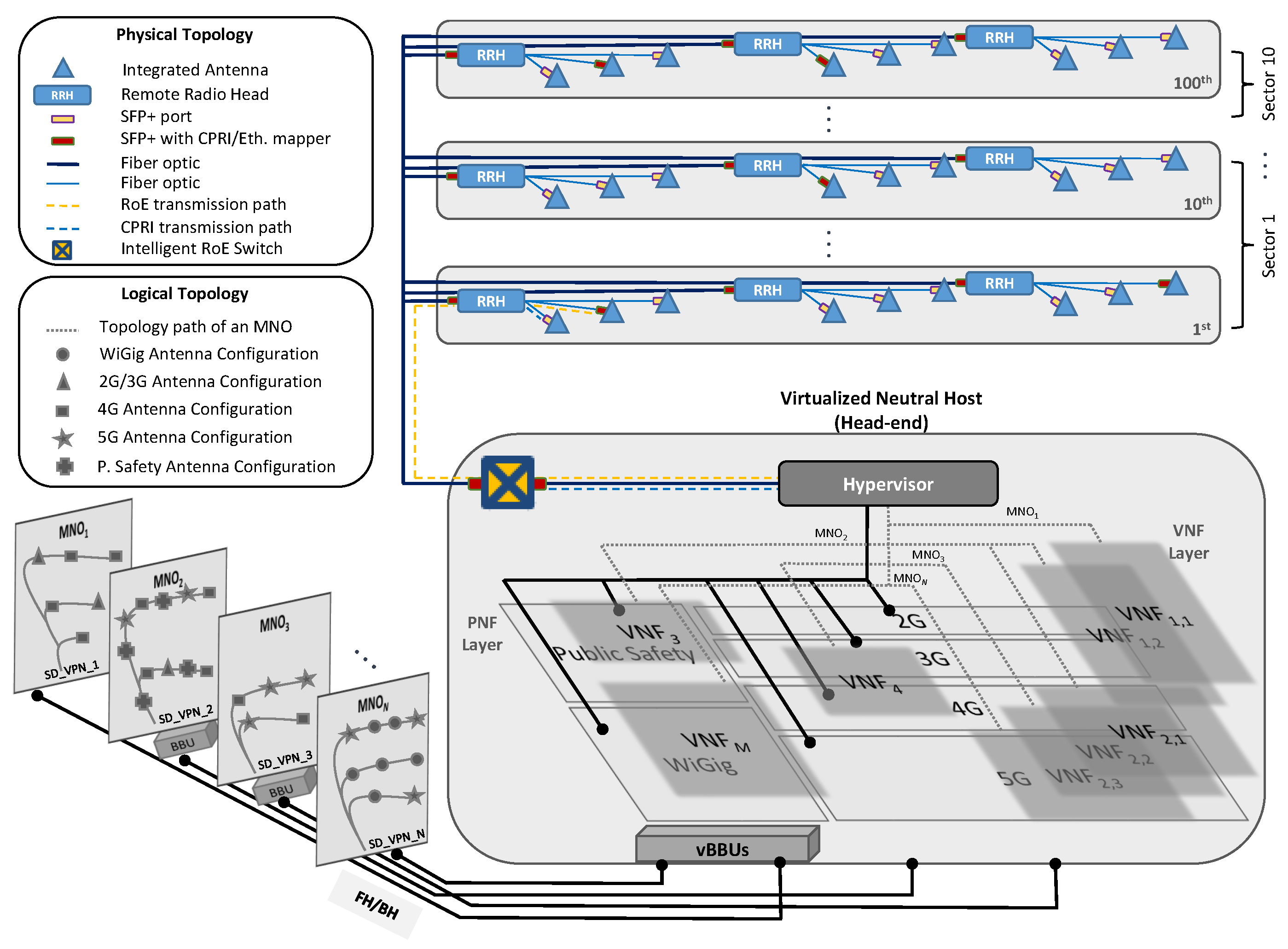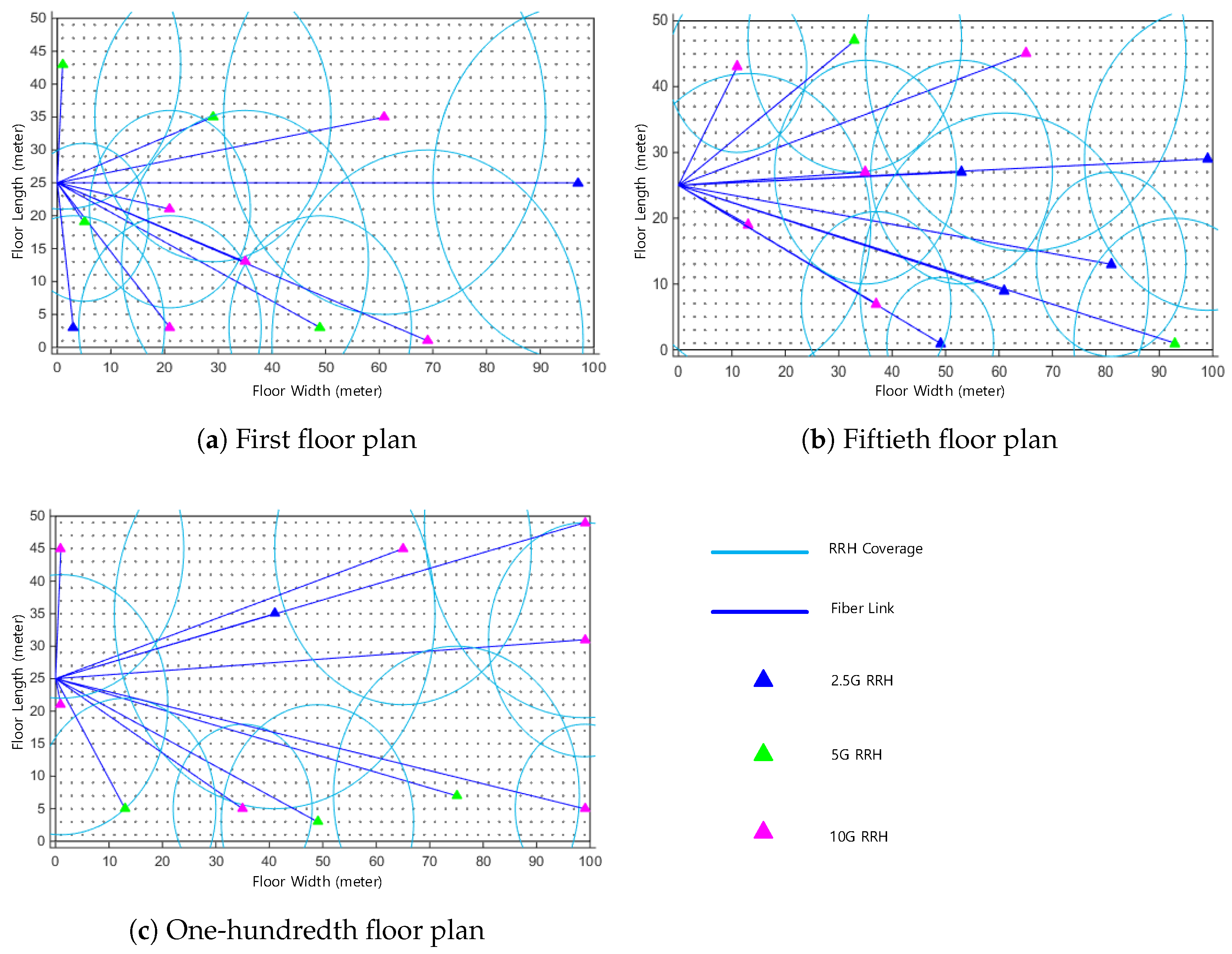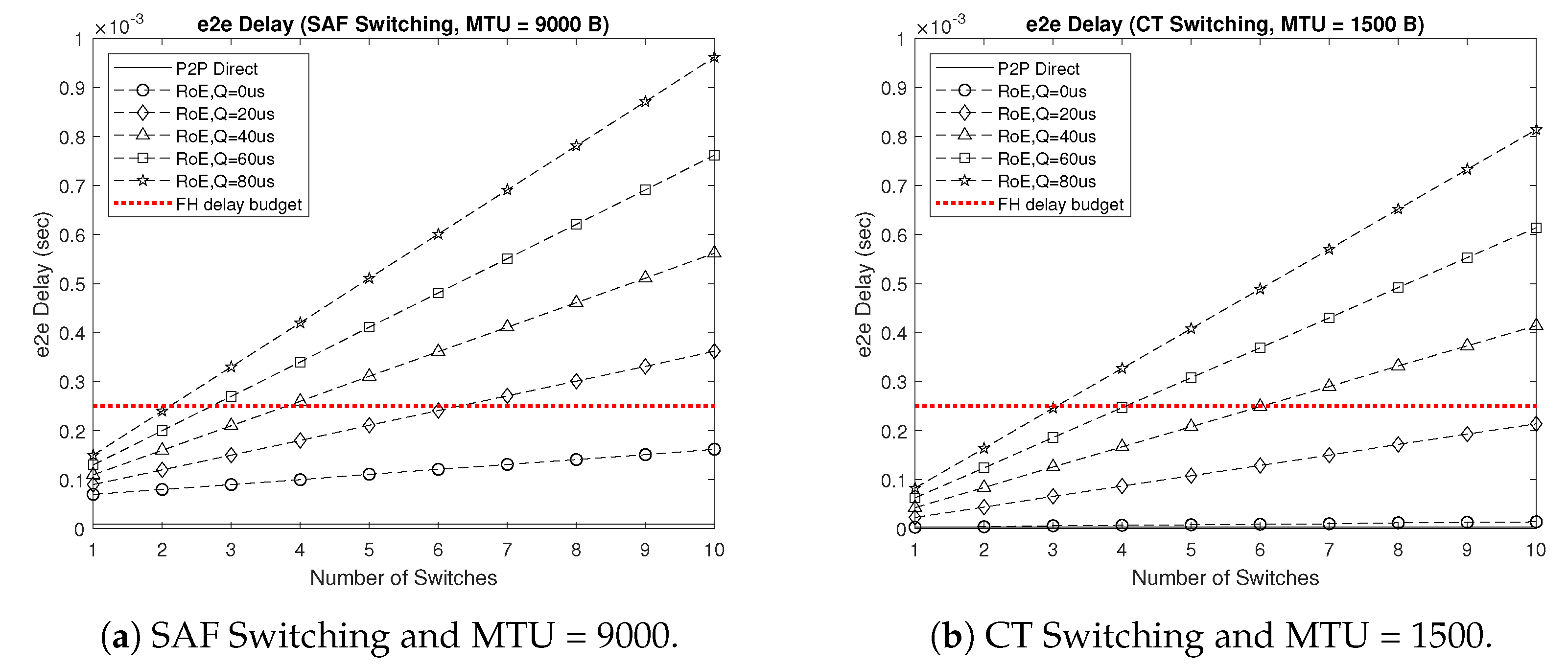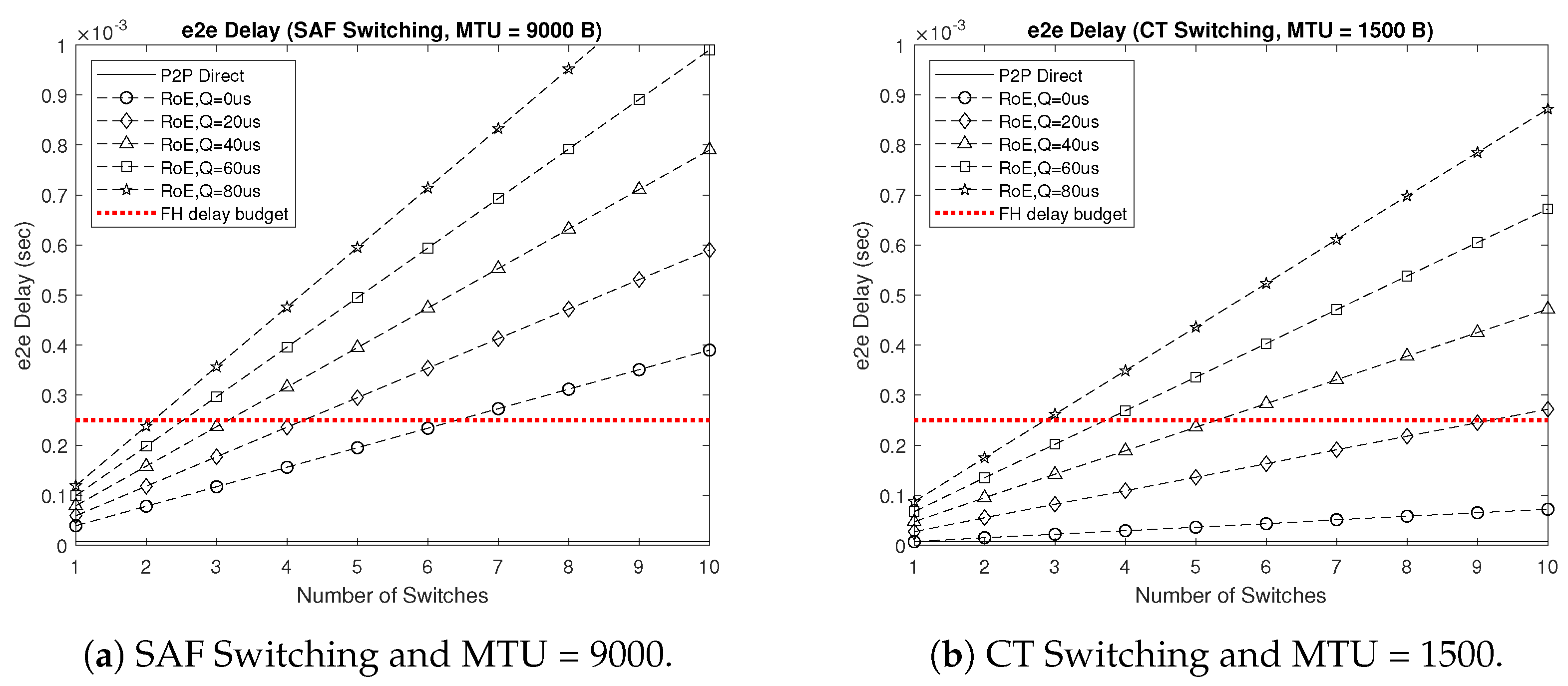A Sustainable Business Model for a Neutral Host Supporting 5G and beyond (5GB) Ultra-Dense Networks: Challenges, Directions, and Architecture
Abstract
1. Introduction
- 1.
- We identify the key technical challenges facing SmC and DAS, as the most prominent UDN technologies, towards the adoption of the neutral host business model in the context of 5GB requirements and use cases.
- 2.
- We explore recent candidate advancements in heterogeneous-network integration technologies to select the ones most suited for the realization of a sustainable 5GB neutral host design capable of accommodating both SmC and DAS based on cost effectiveness and the ability to satisfy the stringent 5GB requirements and diverse use cases.
- 3.
- We propose a novel architecture for the sustainable design of a 5GB neutral host business model that relies on a virtual radio access network (vRAN) based on network function virtualization (NFV) to enable real-time dynamic resource allocation and radio over Ethernet (RoE) for flexible and reconfigurable fronthaul.
- 4.
- We formulate numerical models for the evaluation of the e2e delay and the amount of TCO reduction performance of the proposed design architecture in contrast to that of its conventional point-to-point fronthauling counterpart and that of RoE-only and NFV-only design variations in real-life indoor and outdoor deployment scenarios.
2. 5GB Neutral Host: Challenges and Requirements
2.1. Network Sharing and Multi-Tenancy Support
2.2. Integration with WiFi
2.3. Public Safety Support
2.4. Stringent Fronthaul Requirements
- Frames are transmitted at a constant bit rate regardless of user activity and actual data traffic, where the CPRI signal is typically 50 times the user bit rate.
- CPRI allows only one-to-one (1:1) mapping between RRH and BBU, whereas it is desirable to have many-to-many (M:M) mapping for flexible RRH–BBU affiliation.
- The CPRI line rate increases proportionally to the carrier bandwidth and the number of antennas and sectors considered in the cell configuration, such that in order to achieve the 20 Gbps system capacity required by 5G for an 8 × 8 MIMO 3-sectors cell site and using 256 QAM, the resulting CPRI line rate per RRH grows to a staggering 560 Gbps.
- There is a strict e2e delay to meet HARQ requirements allowing for 100–250 μs only on the FH link, while jitter needs to be maintained in nanoseconds scale.
2.5. Automatic Sectorization and Coverage Control
2.6. Dynamic Resource Allocation
2.7. Zero-Touch Security
3. Design Architecture for Sustainable 5GB Neutral Host Business Model
4. Performance Evaluation
4.1. e2e Delay
4.2. TCO Reduction
5. Conclusions and Future Work
Author Contributions
Funding
Conflicts of Interest
References
- Jonsson, P.; Carson, S.; Blennerud, G.; Shim, K.J.; Arendse, B.; Husseini, A. Ericsson mobility report; Ericsson: Stockholm, Sweden, 2019. [Google Scholar]
- 5G Forum. 5G Vision, Requirements, and Enabling Technologies; White Paper; 5G Forum: Seoul, Korea, 2016. [Google Scholar]
- Andrews, J.G.; Buzzi, S.; Choi, W.; Hanly, S.V.; Lozano, A.; Soong, A.C.; Zhang, J.C. What will 5G be? IEEE J. Sel. Areas Commun. 2014, 32, 1065–1082. [Google Scholar] [CrossRef]
- Kamel, M.; Hamouda, W.; Youssef, A. Ultra-dense networks: A survey. IEEE Commun. Surv. Tutor. 2016, 18, 2522–2545. [Google Scholar] [CrossRef]
- Giordani, M.; Polese, M.; Mezzavilla, M.; Rangan, S.; Zorzi, M. Toward 6G networks: Use cases and technologies. IEEE Commun. Mag. 2020, 58, 55–61. [Google Scholar] [CrossRef]
- Samdanis, K.; Costa-Perez, X.; Sciancalepore, V. From network sharing to multi-tenancy: The 5G network slice broker. IEEE Commun. Mag. 2016, 54, 32–39. [Google Scholar] [CrossRef]
- Ferrús, R.; Sallent, O.; Pérez-Romero, J.; Agustí, R. Management of network slicing in 5G radio access networks: Functional framework and information models. arXiv 2018, arXiv:1803.01142. [Google Scholar]
- Trakadas, P.; Sarakis, L.; Giannopoulos, A.; Spantideas, S.; Capsalis, N.; Gkonis, P.; Karkazis, P.; Rigazzi, G.; Antonopoulos, A.; Cambeiro, M.A.; et al. A cost-efficient 5G non-public network architectural approach: Key concepts and enablers, building blocks and potential use cases. Sensors 2021, 21, 5578. [Google Scholar] [CrossRef] [PubMed]
- Fernández-Fernández, A.; Colman-Meixner, C.; Ochoa-Aday, L.; Betzler, A.; Khalili, H.; Siddiqui, M.S.; Carrozzo, G.; Figuerola, S.; Nejabati, R.; Simeonidou, D. Validating a 5G-Enabled Neutral Host Framework in City-Wide Deployments. Sensors 2021, 21, 8103. [Google Scholar] [CrossRef] [PubMed]
- Cisco, U. Cisco Annual Internet Report (2018–2023) White Paper; Cisco: San Jose, CA, USA, 2020. [Google Scholar]
- Dryjanski, M.; Szydelko, M. A unified traffic steering framework for LTE radio access network coordination. IEEE Commun. Mag. 2016, 54, 84–92. [Google Scholar] [CrossRef]
- Chen, Q.; Yu, G.; Elmaghraby, H.M.; Hamalainen, J.; Ding, Z. Embedding LTE-U within Wi-Fi bands for spectrum efficiency improvement. IEEE Netw. 2017, 31, 72–79. [Google Scholar] [CrossRef][Green Version]
- Sohul, M.M.; Yao, M.; Ma, X.; Imana, E.Y.; Marojevic, V.; Reed, J.H. Next generation public safety networks: A spectrum sharing approach. IEEE Commun. Mag. 2016, 54, 30–36. [Google Scholar] [CrossRef]
- Raza, U.; Usman, M.; Asghar, M.R.; Ansari, I.S.; Granelli, F. Integrating public safety networks to 5G: Applications and standards. In Enabling 5G Communication Systems to Support Vertical Industries; John Wiley & Sons: Hoboken, NJ, USA, 2019; pp. 233–251. [Google Scholar]
- Gomes, N.J.; Chanclou, P.; Turnbull, P.; Magee, A.; Jungnickel, V. Fronthaul evolution: From CPRI to Ethernet. Opt. Fiber Technol. 2015, 26, 50–58. [Google Scholar] [CrossRef]
- Interface, Common Public Radio eCPRI Interface Specification, 2019. Interface Specification, eCPRI Specification v1. 2019. Available online: http://www.cpri.info/downloads/eCPRI_v_1_1_2018_01_10.pdf (accessed on 3 May 2022).
- Pérez, G.O.; López, D.L.; Hernández, J.A. 5G new radio fronthaul network design for eCPRI-IEEE 802.1 CM and extreme latency percentiles. IEEE Access 2019, 7, 82218–82230. [Google Scholar] [CrossRef]
- Shafin, R.; Chen, H.; Nam, Y.H.; Hur, S.; Park, J.; Zhang, J.; Reed, J.H.; Liu, L. Self-tuning sectorization: Deep reinforcement learning meets broadcast beam optimization. IEEE Trans. Wirel. Commun. 2020, 19, 4038–4053. [Google Scholar] [CrossRef]
- Morocho-Cayamcela, M.E.; Lee, H.; Lim, W. Machine learning for 5G/B5G mobile and wireless communications: Potential, limitations, and future directions. IEEE Access 2019, 7, 137184–137206. [Google Scholar] [CrossRef]
- Brik, B.; Boutiba, K.; Ksentini, A. Deep learning for B5G open radio access network: Evolution, survey, case studies, and challenges. IEEE Open J. Commun. Soc. 2022, 3, 228–250. [Google Scholar] [CrossRef]
- 3rd Generation Partnership Project; Technical Specification Group Services and System Aspects; 3GPP System Architecture Evolution (SAE); Security Aspects of Non-3GPP Accesses (Release 15). 2018. Available online: https://www.etsi.org/deliver/etsi_ts/124500_124599/124502/15.00.00_60/ts_124502v150000p.pdf (accessed on 26 March 2021).
- Hotspot 2.0 Specification Version 3.1. Available online: https://www1.wi-fidev.org/file/hotspot-20-specification-package-passpoint-release-3 (accessed on 1 May 2022).
- Jaber, M.; Owens, D.; Imran, M.A.; Tafazolli, R.; Tukmanov, A. A joint backhaul and RAN perspective on the benefits of centralised RAN functions. In Proceedings of the 2016 IEEE International Conference on Communications Workshops (ICC), Kuala Lampur, Malaysia, 22–27 May 2016; pp. 226–231. [Google Scholar]
- Weldon, M.K. The Future X Network: A Bell Labs Perspective; CRC Press: Boca Raton, FL, USA, 2016. [Google Scholar]
- Checko, A.; Berger, M.; Kardaras, G.; Dittmann, L.; Christiansen, H. Cloud radio access network architecture. In Towards 5G Mobile Networks; Technical University of Denmark: Lyngby, Denmark, 2016. [Google Scholar]
- D1.1: Initial Specification of the System Architecture Accounting for the Feedback Received from WP2/3/4. 2016. Available online: https://ec.europa.eu/research/participants/documents/downloadPublic?documentIds=080166e5aa851635&appId=PPGMS. (accessed on 1 May 2021).
- Farias, F.; Fiorani, M.; Tombaz, S.; Mahloo, M.; Wosinska, L.; Costa, J.C.; Monti, P. Cost-and energy-efficient backhaul options for heterogeneous mobile network deployments. Photonic Netw. Commun. 2016, 32, 422–437. [Google Scholar] [CrossRef]
- Bouras, C.; Kokkinos, V.; Kollia, A.; Papazois, A. Techno-economic analysis of ultra-dense and DAS deployments in mobile 5G. In Proceedings of the 2015 International Symposium on Wireless Communication Systems (ISWCS), Brussels, Belgium, 25–28 August 2015; pp. 241–245. [Google Scholar]








| Symbol | Description | Value |
|---|---|---|
| AP | Amortization period | 5 years |
| Cost of a single BBU | USD 00 | |
| Cost of a single RRH of FH capacity 7 2.5/5/10 Gbps | USD 1/1.5/2 k * | |
| Cost of a single SFP port | USD 78 | |
| Cost of fiber cable per km | USD 160 | |
| Cost of trenching per km | USD 130 k | |
| Cost of neutral host equipment | USD 12.8 k | |
| Cost of a single RoE switch | USD 2930 | |
| Cost for backhauling | USD 1170 | |
| Annual site leasing cost | USD 3300 | |
| Annual total cost of running the site | USD 1000 | |
| Power consumption cost associated with coverage radius R of 10/20/30 m | USD 50/100/150 | |
| Multiplexing gain factor | 4 | |
| Coefficient of number of RRH to BBU connections | 0.05 | |
| Coefficient of number of MNOs | 0.05 | |
| Coefficient of implementation cost | 0.25 | |
| Coefficient of site maintenance cost | 0.8 |
Publisher’s Note: MDPI stays neutral with regard to jurisdictional claims in published maps and institutional affiliations. |
© 2022 by the authors. Licensee MDPI, Basel, Switzerland. This article is an open access article distributed under the terms and conditions of the Creative Commons Attribution (CC BY) license (https://creativecommons.org/licenses/by/4.0/).
Share and Cite
Allawi, Y.M.; Mohammed, A.F.Y.; Lee, J.; Choi, S.G. A Sustainable Business Model for a Neutral Host Supporting 5G and beyond (5GB) Ultra-Dense Networks: Challenges, Directions, and Architecture. Sensors 2022, 22, 5215. https://doi.org/10.3390/s22145215
Allawi YM, Mohammed AFY, Lee J, Choi SG. A Sustainable Business Model for a Neutral Host Supporting 5G and beyond (5GB) Ultra-Dense Networks: Challenges, Directions, and Architecture. Sensors. 2022; 22(14):5215. https://doi.org/10.3390/s22145215
Chicago/Turabian StyleAllawi, Yazan M., Alaelddin F. Y. Mohammed, Joohyung Lee, and Seong Gon Choi. 2022. "A Sustainable Business Model for a Neutral Host Supporting 5G and beyond (5GB) Ultra-Dense Networks: Challenges, Directions, and Architecture" Sensors 22, no. 14: 5215. https://doi.org/10.3390/s22145215
APA StyleAllawi, Y. M., Mohammed, A. F. Y., Lee, J., & Choi, S. G. (2022). A Sustainable Business Model for a Neutral Host Supporting 5G and beyond (5GB) Ultra-Dense Networks: Challenges, Directions, and Architecture. Sensors, 22(14), 5215. https://doi.org/10.3390/s22145215






